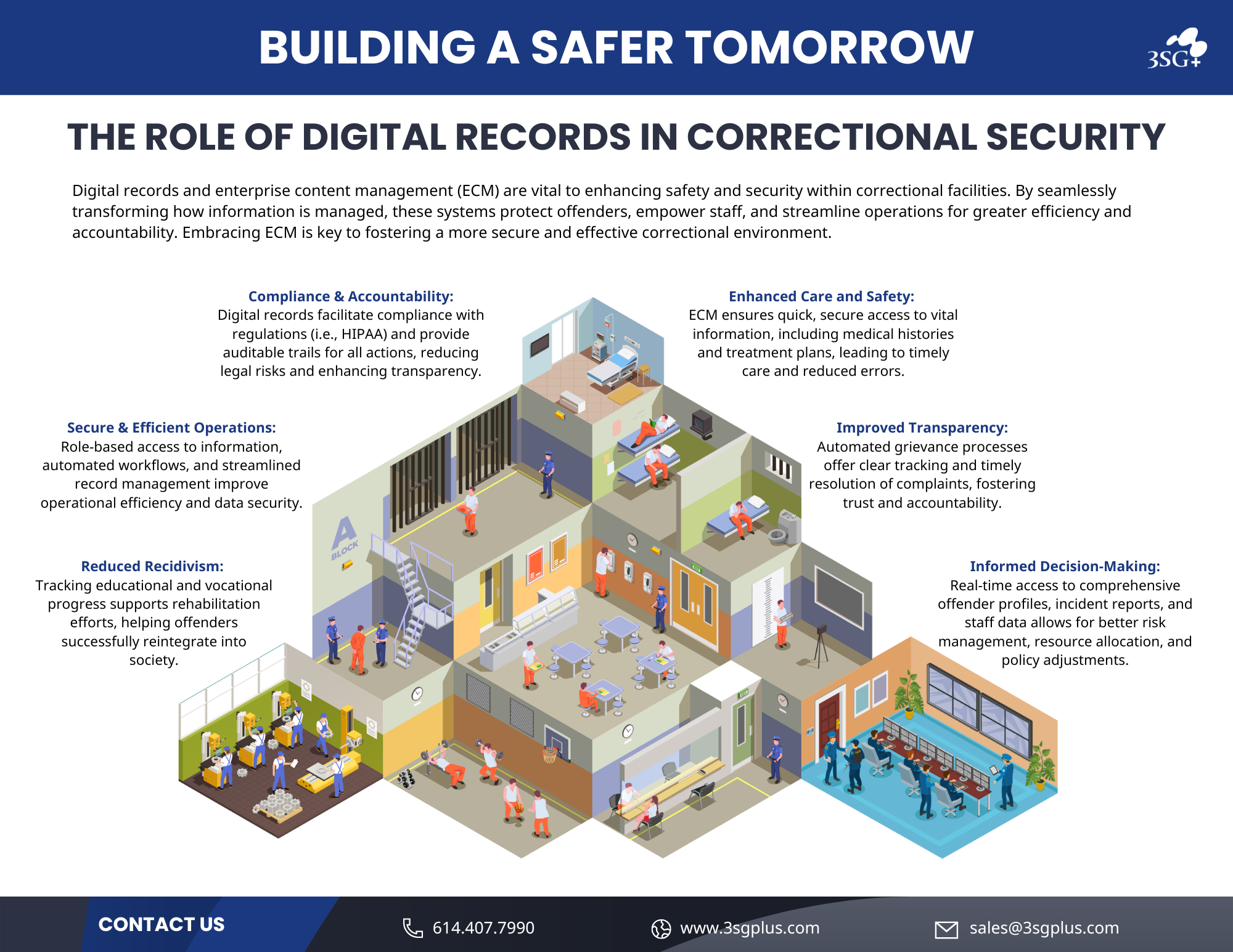
Corrections safety depends on accurate, timely, and secure access to information. Whether it’s responding to incidents, administering care, or managing inmate movement, the ability to quickly retrieve and act on critical data is essential to maintaining a secure facility. Yet many correctional institutions still rely on outdated paper systems or fragmented legacy software that create gaps in oversight, accountability, and responsiveness. As the demands on facilities grow—especially around transparency, compliance, and rehabilitation outcomes—the need for digital transformation becomes increasingly urgent.
Enterprise content management (ECM), particularly in the area of digital records management, is a key driver of that transformation. By digitizing records and automating workflows, ECM enhances visibility, improves coordination, and strengthens the foundation of corrections safety. Facilities can reduce errors, streamline operations, and ensure staff have the information they need to make informed decisions.

Enhancing Corrections Safety Through Efficient Operations
Every correctional facility depends on operational efficiency to maintain safety, order, and effectiveness. But when key processes—such as intake, housing assignments, medical care, education tracking, and parole planning—are still managed on paper or with outdated technology, the risk of delays and errors increases dramatically. ECM replaces these outdated workflows with secure, streamlined digital systems.
By leveraging role-based access to sensitive information and automating document workflows, ECM enables staff to access exactly what they need, when they need it—no more lost files, duplicate records, or bottlenecks. This improves not only operational speed but also enhances data security. Staff can manage documents across departments with better collaboration and fewer redundancies. The result is a facility that operates more efficiently while reducing administrative burden.
Moreover, ECM allows correctional facilities to digitize vast amounts of documentation, from offender files and housing logs to incident reports and staff communications. These digital records can be indexed, searched, and retrieved instantly—saving time and improving accuracy. In high-risk, high-volume environments, those few minutes can mean the difference between escalation and resolution.
Promoting Compliance and Accountability
Correctional facilities must comply with a variety of regulations, including those related to healthcare privacy (like HIPAA), public safety, labor, and civil rights. Noncompliance doesn’t just risk lawsuits or penalties—it undermines public trust and puts vulnerable populations at risk. ECM systems are built with compliance in mind, offering built-in tools for managing retention schedules, enforcing access controls, and tracking audit trails.
Digital records make it easier to provide documentation during audits or investigations and ensure that every action taken—whether a cell check, a medical treatment, or a grievance response—is logged and time-stamped. These capabilities reduce the risk of human error or falsification and give facility leadership greater oversight into daily operations.
More importantly, ECM enhances institutional transparency. Facilities can demonstrate that they are meeting their obligations to protect inmates’ rights, address grievances, and follow legal procedures. In an era where correctional systems are under increasing scrutiny, having defensible, traceable documentation is not optional—it’s critical.
Enabling Safer, More Responsive Care
Incarcerated individuals often face complex health challenges, including chronic illness, mental health conditions, substance use disorders, and histories of trauma. Timely, coordinated care is essential for inmate well-being—but it’s only possible when the right people have access to the right information at the right time.
ECM centralizes medical records, treatment plans, medication schedules, and care team notes into a secure digital environment. With appropriate permissions, medical staff can quickly retrieve relevant data, reducing the chance of treatment delays or harmful errors. This not only protects the health of inmates but also reduces the legal liability of the facility.
In addition, ECM supports interdisciplinary collaboration. For instance, medical, educational, and parole staff can all access shared records, allowing them to coordinate rehabilitation plans and discharge planning. This unified view of the individual leads to better care decisions and a higher chance of successful reintegration into society.
Supporting Rehabilitation and Reducing Recidivism
Corrections isn’t just about containment—it’s also about rehabilitation. Yet tracking vocational training, education, counseling sessions, and behavior evaluations can be logistically overwhelming, especially when scattered across paper files and isolated databases. ECM consolidates this information into a single, easy-to-manage digital profile for each individual.
Staff can monitor progress, set goals, and adjust programming based on real-time data. Offenders benefit from more personalized rehabilitation plans, and administrators gain a clearer picture of what interventions are working. These insights are invaluable for reducing recidivism, as they help ensure that offenders are supported in meaningful ways that prepare them for reentry.
By using digital records to support case management, facilities can more effectively advocate for inmates who are ready for parole, qualify for early release programs, or need specific community services upon release.
Transparency and Trust Through Grievance Management
An often-overlooked aspect of correctional management is the handling of grievances. When inmates file complaints—about safety, treatment, access to services, or staff conduct—there must be a system in place to track, investigate, and resolve those complaints fairly and efficiently. ECM streamlines this process through automated workflows.
Each grievance can be logged, routed to the appropriate reviewer, and tracked through resolution. This automation eliminates delays, reduces the risk of mishandling, and ensures that responses are consistent and well-documented. When inmates see that complaints are handled with care and transparency, it fosters greater trust in the system and reduces tensions within the facility.
Moreover, the data collected through grievance records can highlight patterns or recurring issues, enabling proactive leadership intervention before they escalate into safety threats or legal action.
Better Decisions with Real-Time Data Access
Correctional leaders are tasked with managing limited resources—whether it’s staffing, housing capacity, programming slots, or medical care. Without access to up-to-date, comprehensive data, decision-making becomes guesswork. ECM equips leaders with real-time dashboards, reports, and search capabilities, all drawn from centralized digital records.
Administrators can identify trends in incident reports, staffing shortages, and inmate health needs. They can use this information to plan shift schedules, allocate funds, or revise policies. For example, a sudden spike in grievances or medical requests in one housing unit might prompt an investigation into staffing levels or facility conditions.
This level of situational awareness allows corrections leaders to not just react—but to anticipate and adapt.
How 3SG Plus Helps Improve Corrections Safety
Choosing to adopt ECM is only the first step. Designing, implementing, and maintaining a secure, scalable, and effective digital records system requires expertise.
As a trusted reseller and integrator of enterprise content management solutions, 3SG Plus partners closely with correctional institutions to deliver tailored ECM strategies. We don’t just sell software—we offer a full-service approach that includes discovery, planning, deployment, training, and ongoing support.
Our team understands the regulatory requirements, institutional culture, and operational constraints of correctional environments. We work side-by-side with staff to ensure that the solution is configured to meet their needs—from automating intake and case management to supporting compliance and transparency.
We also provide managed services to help facilities maintain and upgrade their systems over time. This includes everything from technical troubleshooting to system optimization and performance reporting. With 3SG Plus, correctional leaders don’t just gain a tool—they gain a partner in digital transformation.
Final Thoughts on Corrections Safety
Correctional security isn’t just about surveillance and fences—it’s about managing information wisely. Digital records and ECM help protect inmates and staff alike, ensure regulatory compliance, and support the mission of rehabilitation. They bring clarity, consistency, and control to an environment where these qualities are often hard-won.
With the support of a knowledgeable partner like 3SG Plus, correctional facilities can unlock the full potential of ECM—designing solutions that meet their unique needs and empower them to build safer, more transparent, and more effective institutions.
